
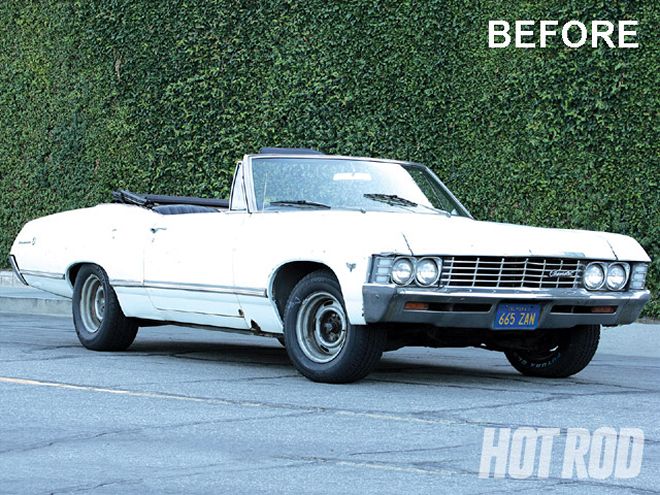 Here's our '67 Impala convertible that we scored on eBay for $4,805.50. It's kind of a beater, but we drove it for a year without ever wrenching on it before we decided it was time for a makeover.
Here's our '67 Impala convertible that we scored on eBay for $4,805.50. It's kind of a beater, but we drove it for a year without ever wrenching on it before we decided it was time for a makeover.
We're constantly on the hunt for new ideas in gearhead land, but with this one, we may have been a little slow on the uptake. After all, we've seen it on the Power Tour bus for like five years, not to mention on fleet vehicles, NASCAR race cars, Funny Cars, and plenty more. But it finally hit us: why not do a vinyl wrap instead of a paint job on a regular ol' street machine? We decided to investigate the pros and cons along with 13-year vinyl-wrap veteran Loren Traister of Canby Graphics, who executed the design and the wrap on the Hot Rod Mustang that Editor Rob Kinnan raced in the Ford Racing Mustang Challenge series last year. Traister also wrapped our '67 Impala for this story so we could take a closer look at the process.
FAQ
Q: What is a wrap, anyway?
A: A wrap involves skinning an entire vehicle with a special, thin vinyl material that is adhesive-backed and can be printed with an almost limitless variety of designs. On the Impala seen here, the entire car is wrapped, not just the flamed part. However, smaller portions of a car can be spot-wrapped, or all the painted surfaces can be covered. With special perforated, see-through materials, even the windows can be wrapped.
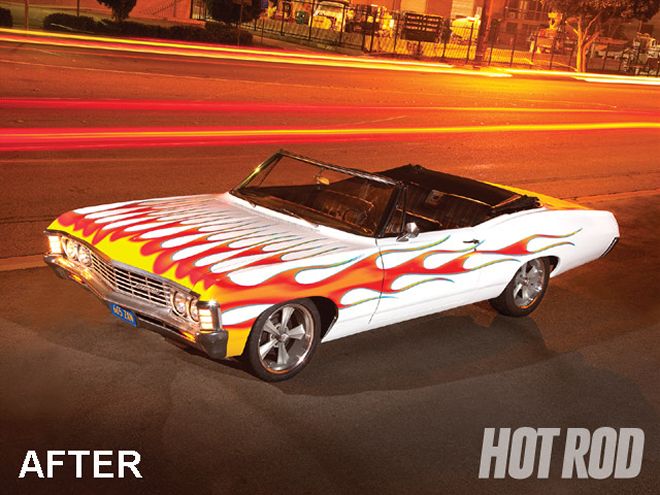 The revamped Imp features a complete vinyl wrap in addition to a few new trim parts from Classic Industries, some 18x8 Rocket Racing wheels with Mickey Thompson Sportsman SR Radial tires, and a drop job courtesy of the blue wrench.
The revamped Imp features a complete vinyl wrap in addition to a few new trim parts from Classic Industries, some 18x8 Rocket Racing wheels with Mickey Thompson Sportsman SR Radial tires, and a drop job courtesy of the blue wrench.
Q: What kinds of designs are possible?
A: The designs are generated in the Photoshop and Illustrator computer programs and are limited only by personal creativity. You can do all sorts of crazy things with real photos, hand-drawn or computer-generated designs, and typography, or you can keep it simple like we did with our flame job. The possibilities with graphics on vinyl wraps are much more extreme than what can practically be done with paint. See some ideas on page 86.
Q: Are there color limitations?
A: There's currently no way to do metallics, candies, or fluorescents on vinyl, though Traister says that a reflective wrap is available that looks sort of metallic in daylight, but it's super expensive (like five times more than a regular wrap). Flat, no-sheen materials are also an option, and flat black is very popular on new cars (do a Google search on "murdered out" to learn more about that craze). Canby Graphics is working on a system where gloss graphics can be added over a satin base.
Also, the colors will not look exactly like paint because they are printed on the vinyl with solvent-based inks in a very tight dot pattern. Colors look just a little hazier and the edges are just a little softer than what's possible with paint.
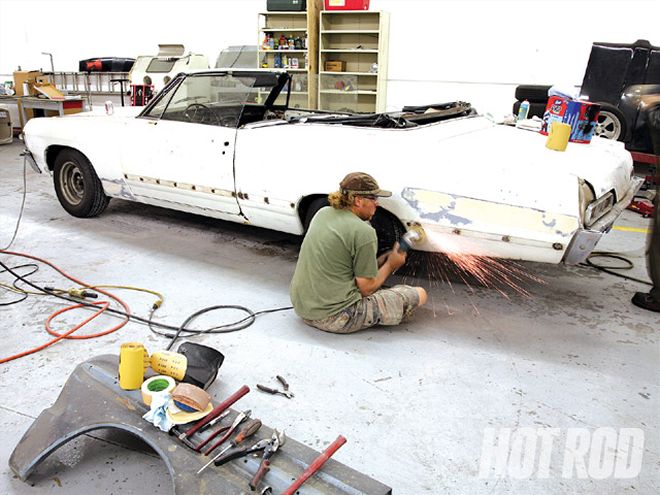 To prep for the wrap, we did as much bodywork as we could in two 20-hour days, including removing much of the trim, filling a bunch of holes, welding in some patch panels, banging out dents, and sanding our brains out. We send huge thanks to John McGann of Car Craft magazine who volunteered to tough it out with us so we could meet the deadline and who lent us many bodywork tips.
To prep for the wrap, we did as much bodywork as we could in two 20-hour days, including removing much of the trim, filling a bunch of holes, welding in some patch panels, banging out dents, and sanding our brains out. We send huge thanks to John McGann of Car Craft magazine who volunteered to tough it out with us so we could meet the deadline and who lent us many bodywork tips.
Q: Can pinstriping or other spot paints be added on top of the vinyl?
A: Yes, paints such as One-Shot will adhere, though you can't add a clearcoat over them.
Q: Will wrapping hurt the existing paint job on the car?
A: No, today's best materials made by 3M have a special adhesive that comes off clean. Traister says it only takes 20 minutes to remove a complete wrap from a typical car and that there's almost no cleanup. We've seen people add wraps to brand-new cars and the vinyl can serve to protect the paint.
Q: Are there various grades of vinyl available?
Traister says, "There are two different grades of vinyl you can wrap with, calendered vinyl and cast vinyl. Calendered vinyl will have a life span from six months to two years depending on where the vehicle is located. Calendered vinyl won't conform in channels or around heavy compound curves as well as cast vinyl. Cast vinyl is typically recommended for all vehicle wraps due to its conformability and dimensional stability." Also, Traister uses 3M products exclusively and says they are noticeably higher in quality than others on the market.
Q: How long will a wrap last?
A: Assuming the superior cast product is used, the typical life is five years. The printed vinyl is covered by a clear laminate with UV protection. After five years, the sunnier the environment, the quicker the degradation.
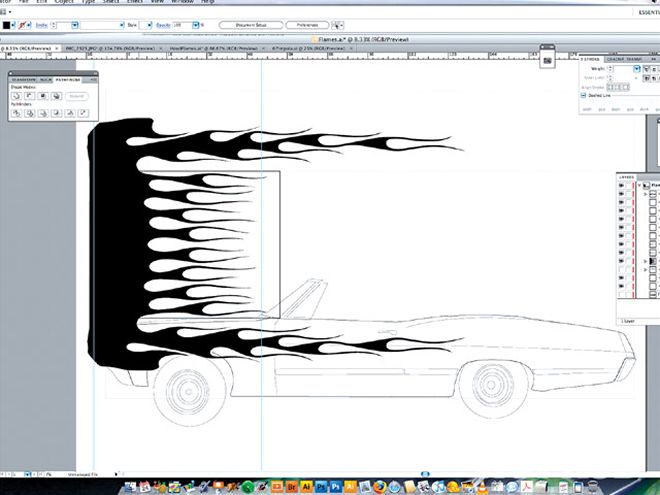 We decided to go with a mainstream flame job and sent Loren Traister of Canby Graphics a number of sample photos of cars with the types of flames we liked. He created the flames as shown here using a computer program called Illustrator, where the shape and colors could be manipulated into exactly what we wanted.
We decided to go with a mainstream flame job and sent Loren Traister of Canby Graphics a number of sample photos of cars with the types of flames we liked. He created the flames as shown here using a computer program called Illustrator, where the shape and colors could be manipulated into exactly what we wanted.
Q: Are there any problems with the edges lifting up over time?
A: Traister says, "Vinyl wraps are not paint. You can get a wrap to look very good for most applications, but over a short time, extreme channels and edges can lift. Any lifting that may happen will typically be in the first few weeks. If installed properly, it's typically very minimal and does not compromise the appearance." Of course, pro installation over a clean surface is also critical. For tight bends and channels, Traister uses 3M adhesion promoter to prevent lifting.
Q: Does it matter if the car's existing paint surface is not shiny?
A: No, the vinyl will adhere to either polished or flat surfaces such as primer, but they must be free of dirt, wax, and grease.
Q: Will the vinyl hide colors and bodywork underneath it?
A: The adhesive backing is usually gray and totally opaque; on our Impala, it completely concealed all the primer spots. However, we learned the hard way that the vinyl hides nothing in the way of scratches or dents. We were hoping that it had some ability to cloak surface imperfections, but it conforms so well that you can even see 220-grit sanding scratches through the vinyl. Body prep needs to be almost as thorough as if you were ready to spray a finish coat of paint.
Q: How do you care for the vinyl versus paint?
A: Vinyl does not need to be waxed. It can be easily cleaned up with a spray-detailer product. Pressure-washing such as in commercial car washes is not recommended because it may lift the edges of the vinyl.
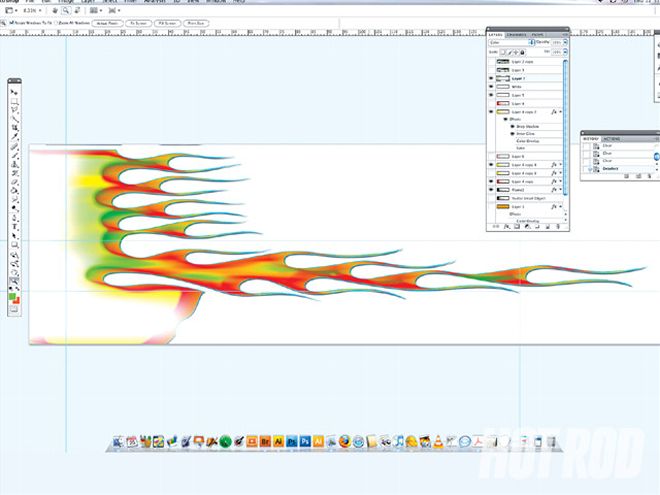 Using Photoshop, Loren worked on the colors and fades in the flames. This is a version we all agreed just did not work with the green.
Using Photoshop, Loren worked on the colors and fades in the flames. This is a version we all agreed just did not work with the green.
Q: Are there body styles that are too difficult to wrap cleanly, like a stepside pickup, for example?
A: Traister says, "Yes, there are some limitations on how the vinyl can be stretched without lifting and while holding the exact color. We usually need to panel or splice those sections so they will adhere better. On very extreme curves, you may get some difference in color due to the ink thinning as the vinyl is stretched to conform to the surface."
Q: How large are the individual vinyl panels and will there be obvious seams in the final product?
A: Vehicle wraps usually use vinyl that comes in widths of 54 or 48 inches. In the instance that there aren't any body panel lines to use for panels, you would then have a seam.
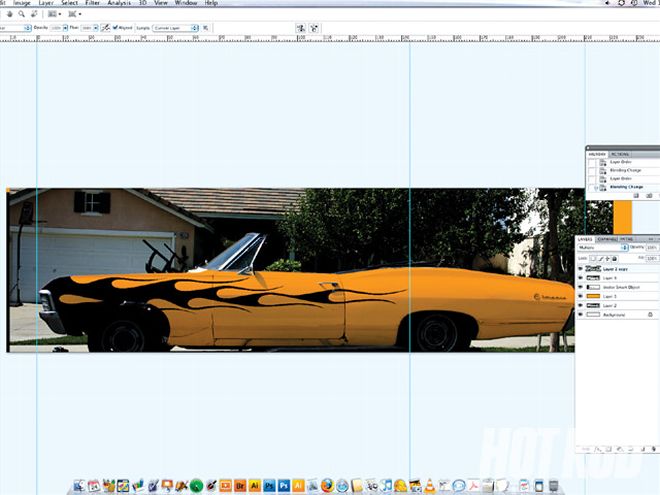 Also in Photoshop, a real image of the car was used to give us an idea what the graphics would look like once installed. We thought this orange-and-black idea might work but rejected it once we saw this. After we approved a final design, it was printed on sheets of white vinyl. Each side of the car's graphics is an exact mirror image of the other.
Also in Photoshop, a real image of the car was used to give us an idea what the graphics would look like once installed. We thought this orange-and-black idea might work but rejected it once we saw this. After we approved a final design, it was printed on sheets of white vinyl. Each side of the car's graphics is an exact mirror image of the other.
Q: Does the wrap have to cover the entire car?
A: No. It's possible to do portions of the car, like only the roof or only below the beltline. You can also do highlights, such as between the trim on the quarters of a '57 Chevy. Many installers, including Canby Graphics, can also do die-cut spot wraps. An example of this would be doing just the flames on our Impala rather than skinning the entire car.
Q: Can jams be wrapped?
A: Typically, installers do not wrap the jams, but the edges are cut and tucked for a paint-like appearance. Mismatched jam colors would be noticeable when trunks or doors are opened, though it's possible to color-match closely enough to a common spray paint color that jams could be cheaply spray-matched.
Q: How much does it cost to wrap a vehicle?
A: Traister says, "The biggest factor that will affect overall price is the amount of coverage. Not all wraps cover 100 percent of the paint on a car. If we were to do 50 percent coverage, you are typically looking at 50 percent of the total cost. Design time is another factor in price; we charge $80 an hour on top of the square footage amount. A typical wrap will have around 8 hours of design, and extreme ones can be 16, but we have done some that take as long as 80 hours. Colors have no effect on the price-it's all based on square footage and the difficulty of installation." The bill for the work on our Impala seen in this story is about $3,500.
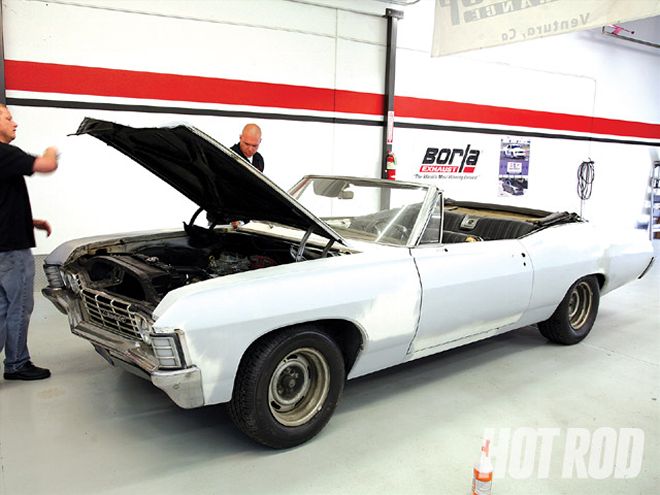 The Canby Graphics shop is near Portland, Oregon, but Traister did our wrap work at Aaron Hoekstra's Hoek'd Up Performance in Oxnard, California. The job began by thoroughly wiping down the car with isopropyl alcohol. Note that all the body filler is covered with primer; the vinyl will not stick to filler.
The Canby Graphics shop is near Portland, Oregon, but Traister did our wrap work at Aaron Hoekstra's Hoek'd Up Performance in Oxnard, California. The job began by thoroughly wiping down the car with isopropyl alcohol. Note that all the body filler is covered with primer; the vinyl will not stick to filler.
Pros
If you're just looking for a basic color change, wrapping is not the best option. You can get a car painted in a single color for less money than a basic wrap. But if you're considering graphics of any kind, then a wrap can save huge time and money while also giving far more design options. The flames alone on our Impala would cost at least twice as much as the wrap if we had them custom-painted.
Wrapping also has advantages because it is like a temporary tattoo. You don't have to make a huge commitment to a graphic paint scheme only to end up having it look dated in a couple of years; when you're tired of it, just peel it off. You could put a new wrap on your car every year for three or four years before the money added up to the cost of a single graphic paint job.
Another advantage of wraps is instant gratification. The job can be done in a single day rather than waiting for your car's parole from paint jail.
Because your wrap artist can keep your design in his computer indefinitely, he can also print new panels anytime you want, making any repairs much easier in the event of a fender bender. Rewrapping a fender or even one entire side of the car is far cheaper, easier, and more of an accurate match than trying to redo custom paintwork. That makes it a great option for a road race car.
The repeatability of the wrap design also makes it perfect for anyone with a fleet of cars that need to look identical (such advertising-related use is actually the mainstay of wrap shops). Because the computer design files are so easy to change, it would also be possible for you to have the same basic look, but with different colors, on all your family's cars or on all the cars in your club. Likewise, you could have identical colors but with different lettering.
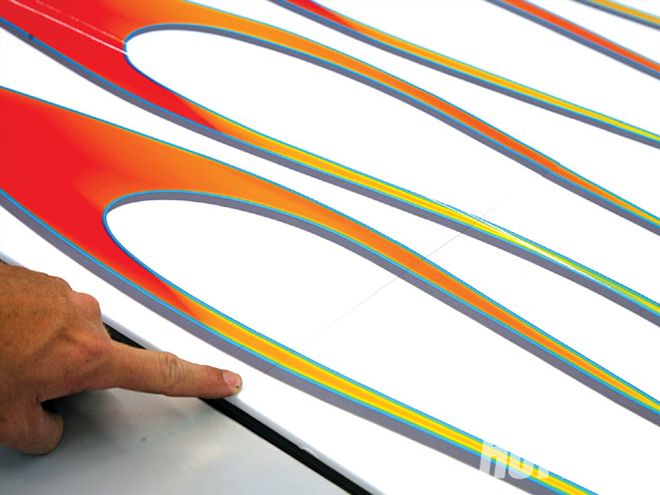 The very first panel installed was the hood, as it was the anchor that all the others were centered on. Normally, if Traister was working in his own shop, he might print one panel at a time and then make adjustments to ensure alignment before printing the next panel. In our case, everything was printed at once and then shipped to California.
The very first panel installed was the hood, as it was the anchor that all the others were centered on. Normally, if Traister was working in his own shop, he might print one panel at a time and then make adjustments to ensure alignment before printing the next panel. In our case, everything was printed at once and then shipped to California.
Wraps also have the ability to protect your existing paint job. You could buy a brand-new red Camaro, have it wrapped in satin black, live with that a few years, then peel it off and have a mint-condition, bright-red paint job.
The design process of the wrap can give you an exact photo illustration of what the final product will look like, which can be more helpful and realistic than getting illustrations, or even photo renderings, of a proposed paint-scheme design.
The last upside to a wrap is that its simplicity can open up ideas you might never consider for paint, such as doing your trailer or toolbox (see ideas on page 96). The printer and die-cutter may also be used to create templates that can be used for custom paint jobs.
Cons
A downside of the vinyl is that it does not look exactly like paint. The colors are a little softer due to the printing process, and on close inspection, it's obvious that the car has been wrapped rather than painted. The wrap is especially noticeable in places where two vinyl panels overlap, and those seams most often fall on the hood.
Also, because of the stretchiness of the vinyl itself, depending on the skill of the wrap installer, there can be problems with designs that rely on perfectly straight lines (for example, a '60s-drag-style candy-striped roof) or on design elements that must follow exactly along factory body lines (for example, on a Watson-style panel-paint job).
Finally, a well-prepped paint job can last forever, while a wrap has only a five-year life expectancy.
Conclusions
In all, we think wraps are pretty cool. They open up new worlds of creativity in design, and it's easier to take risks because they are not as much of a commitment as a paint job. Compared with painted graphics, wraps are cheaper, faster, easier, and have more options as long as you don't want a candy or metallic look. Wraps are not for every person or for every project, but they're another kink in the hot rodding world.
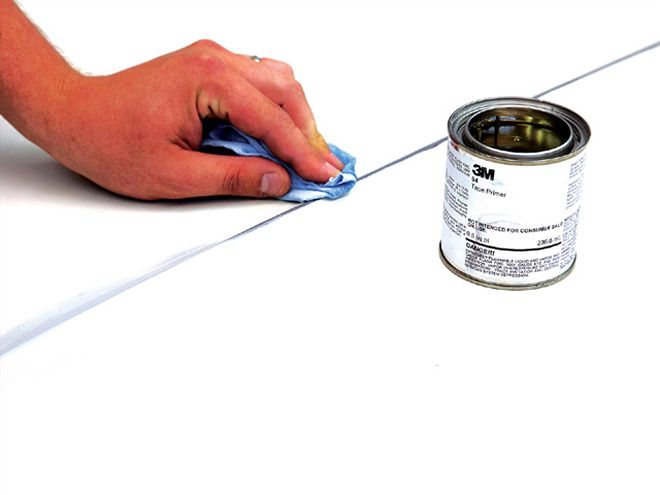
On complex shapes, such as the peaked center rib of our hood, 3M 94 Tape Primer is used to help ensure adhesion. When the vinyl is later peeled off, the spots that were primed like this will be the only ones with glue left behind to clean up.

Due to the 58-inch-max width of the vinyl, the hood could not be wrapped with a single piece, so there is a seam in the middle that you can barely see at the finger. The vinyl must overlap by 1 inch at the seams. On darker colors or with more complex graphics, the seam is less noticeable. The material is 2 mils thick with a 2-mil clear laminate on top.
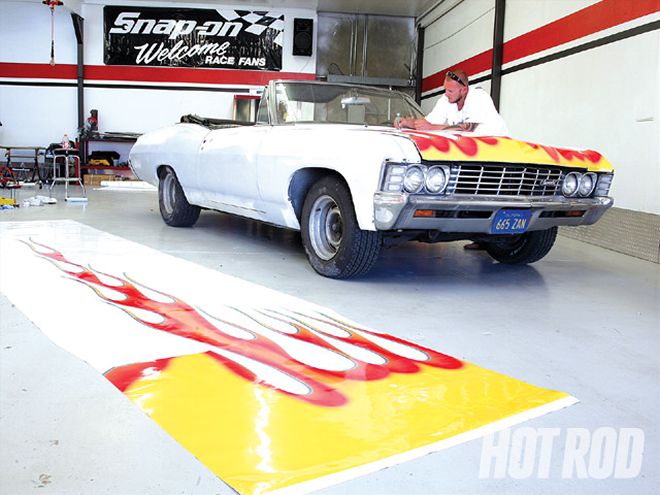
The entire sides of the car were wrapped using single, massive sheets of vinyl that look like this before the backing is peeled off. In the background, Brandon Wolliver is manning the tedious task of cutting and folding the vinyl into the slots of the cowl vent.
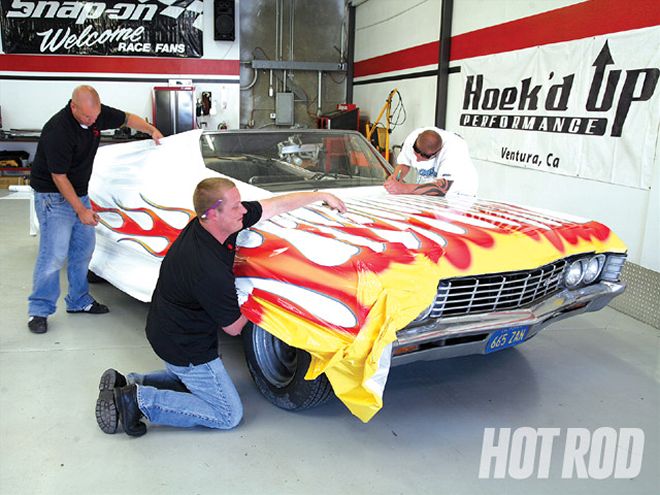
With help from Randy Wooliver, Traister began wrapping the sides by establishing the exact point where the flames needed to meet the hood. The vinyl looks like a mess right here, but the 3M Controltac Comply Version 3 product is simply amazing in its ability to stick and restick, smoothly conform, attenuate the air bubbles, and be malleable to the installer. It's really baffling-far different from just a giant sticker. The price of this material is a big part of the expense of the job.
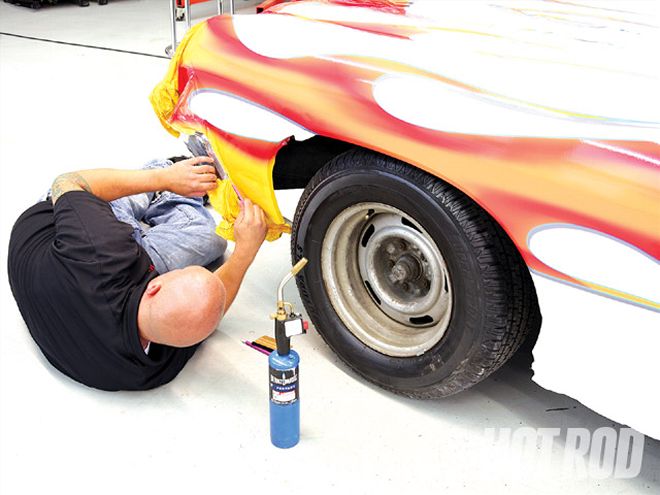
With the broad surfaces of the car covered, the detail work involved trimming all the edges with a razor blade and shaping them around all the little bands and corners. This tends to require heating, but not melting, the edges so they smoothly fold around tight corners on the wheelwells and rocker panels.
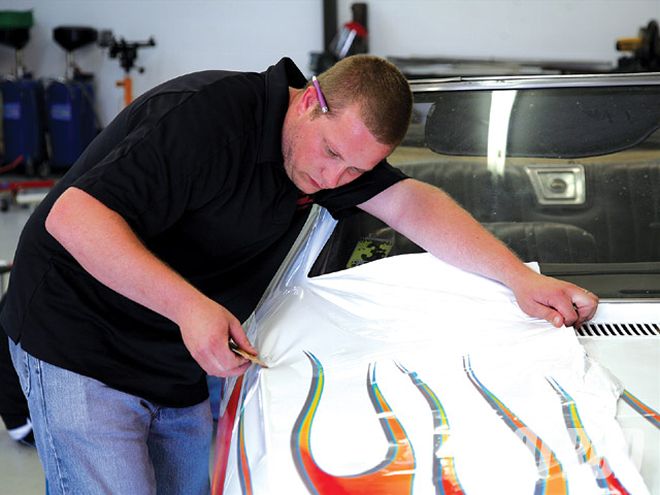
In watching Traister and Wolliver work, it was obvious that quality installation takes skills learned with experience. These guys stretched and manipulated the vinyl while working it with fabric-covered squeegees and softening and shrinking it with propane torches to get it to perfectly conform to the car while also landing in the right places side to side. Any hole poked or burned into the material would have been an instant fail, but it didn't happen.
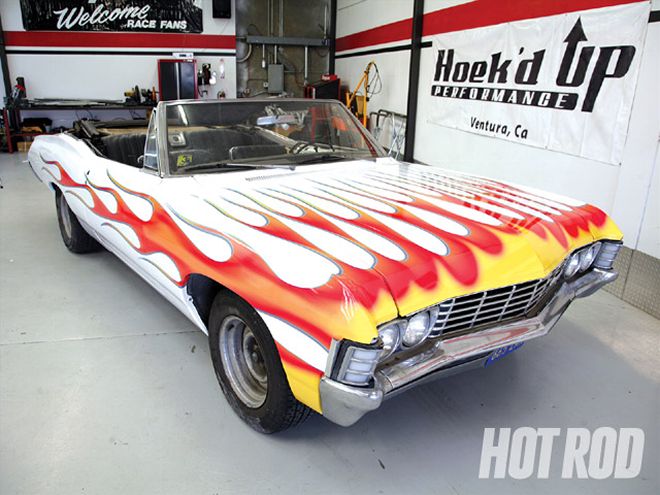
The three guys wrapped the entire car with five huge pieces of the 3M vinyl in about six hours, including a pizza break. The only flaws were in our sketchy bodywork. It was ready for new hood and eyebrow trim and quarter-panel emblems from Classic Industries, plus new rollers from Rocket Wheels and Mickey Thompson.
Wheels And Tires
We've been dying to use one of the new retro designs from Rocket Racing Wheels. The company makes low-cost, imported wheels in two very cool five-spoke designs: the Fuel (with curved spokes) and the Booster (shown). Both are available in polished, chrome, or gray. Ours are 18x8s with 4.75-inch backspacing; 17x7s, 17x8s, 18x7s, 18x9s, and 20x8s are also available.
We had trouble finding performance radials in a style that offered the 26-inchers we needed for the front and also in the tall 28s we needed out back. The solution was Mickey Thompson Sportsman SR Radials in sizes of 26x10-18 and 28x10-18.
We found the tires to be slightly smaller than the specs, measuring 9 1/4 inches wide and 25 1/4 tall up front and 9 5/8 inches wide and 26 3/4 inches tall out back. The wheels have a tad more backspacing than we'd prefer, but that will be solved with disc brakes, which increase the track width. We lowered the car about 3 inches in front and 1 in the back, and the tires do not rub . Tread Source handled our mounting and balancing and nicely hid all the weights behind the wheel spokes.